by Winding Pathways | Nov 24, 2022 | (Sub)Urban Homesteading, Birds, Bugs, Flowers/Grasses, Foraging, Garden/Yard, Nature
We think of fall as migration time when all the birds leave. And there is a great birdcast website to see in live time the flights. But an autumn walk through a park with wild edges reveals shrubs, bushes, and grasses alive with bird activity. Visit an orchard on a cold winter day and the odds are good for spotting robins pecking on frozen dropped apples, but wild fruits are more common, all just beyond suburbia.
Let’s step back to spring. When Rich worked at the Indian Creek Nature Center his phone would often ring during those first warm days. With excitement callers would announce that the robins had returned. Spring’s here!
Seeing a robin on a spring lawn gives the illusion that they’ve just made a long journey from a faraway wintering ground down south. Robins, bluebirds, and other birds usually just shift where they live and forage as seasons change.
Ecological Survivors
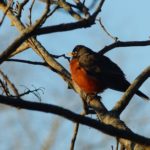
A robin surveys the area
Robins, in particular, are ecological survivors. They’re adapted to living on lawns and around people during the warm months, where they nest on porch eaves and forage for worms and bugs in mowed grass. The coming of fall’s cold marks the disappearance of robins from suburbia. They don’t go far and make an amazing dietary switcheroo to wild fruits.
Robins and bluebirds shun their summer buggy and wormy diet and shift to fruits and some seeds come winter.
On an October walk, we spotted several wild fruits – berries perhaps – that birds feast on during the cold months. the native plants are great – even the poison ivy – the exotics are problematic.
Here are some common winter weedy and seedy plants:
- Gray Dogwood. This small native dogwood often forms thickets along trails, parks, woods, and even yards and holds plenty of berries into cold months.
- Wild grapes. People rarely eat sour and seedy wild grapes, and sometimes birds also leave them alone during summer, but come winter the raison-like grapes make nutritious avian fare.
- Poke Weed. In late fall this tall purple-stemmed and fruited plant is hard to miss. Birds eat the frozen berries. Note: Poke berries are toxic to people and many mammals but not birds.
- Poison ivy. Gulp. This bane of allergic people is a beneficial wildlife plant. Deer and rabbits browse on the woody sprouts and birds feast on the berries.
- Asian Honeysuckle, Japanese Barberry, and Oriental bittersweet are “dirty bird plants.” Actually, birds love the berries and carry them far and wide to poop out the seeds. All three exotic plants are highly invasive and crowd out more desirable native plants. Birds have helped them conquer woodlands and field edges to the detriment of healthy bio-diversity.
-
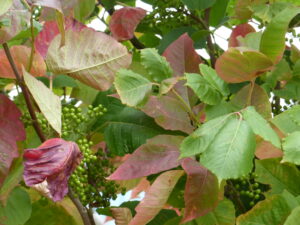
-
Poison Ivy berries are a favorite of birds.
-
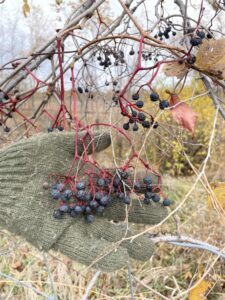
-
Wild grapes are a tasty winter treat.
-
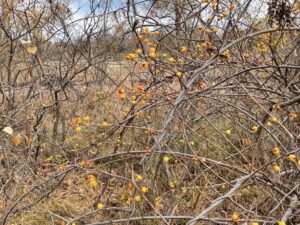
-
An invasive species and favorite of birds.
Winter Fare Is More Than Fruits
Winter bird fare isn’t just fruit. Many birds glean frozen spiders and insects from crevices in tree bark and dozens of species continue to eat grass and “weed” seeds. That’s a problem with mowed lawns. They produce no seeds, so few birds visit them during the colder months. Taller growing grasses, flowers, and shrubs often hold their seeds into the winter and are bird magnets.
-
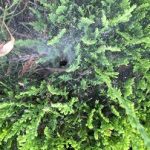
-
This beneficial spider controls insects in the yard.
-
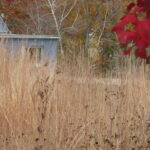
-
Birds bob on prairie grasses.
-
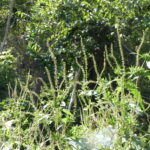
-
Ragweed seeds last through the winter.
Want to have birds in the yard all winter? Keeping feeders stocked helps, but better results come when homeowners encourage buffers of native shrubs, vines, and grasses that produce natural winter bird food and habitat. Most people love their tidy lawn, but edging the lawn, usually along a property line, or creating “pocket prairies” with native or desirable tall grasses, wildflowers, and shrubs adds summer color and year-round wildlife appeal. So, we encourage readers to create and leave wilder spaces for the birds!
by Marion Patterson | Nov 10, 2022 | Birds, Nature
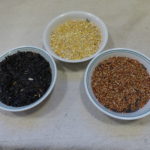
Sunflower seed, cracked corn, milo.
Feeding backyard birds is fun, but it’s become expensive. The price of black oil sunflower seed has doubled in just a couple of years.
To keep our birds well-fed and our budget under control we use Fourth Story Feeders. What are they? Well, the first story is the ground. The second is a picnic table or other platform a few feet off the ground, and the third is a metal shepherd’s hook shoved into the ground that gets feeders up four or five feet. We use all these and increasingly have taken the feed up the elevator to the fourth floor.
Raccoons, deer, opossums, and even bears love a nocturnal snack of expensive bird seed. Squirrels and wild turkeys gobble it up during the day. These animals easily access seeds on the first, second, and third floor – but not the fourth. Except for bears who can create complete havoc with feeders left out overnight.
Here’s how we created a feeding station that’s easy for birds to reach but inaccessible to deer, turkeys, raccoons, and opossums:
- Bought the tallest shepherd’s hook we could find.
- Pulled our homemade picnic table to a spot easy to see through our windows.
- Drilled two holes in the wooden table exactly the size of the “feet” of the shepherd’s hook. Used a hammer to lightly tap the “feet” into the holes.
- Suspended silo and suet feeders from the hooks that are now eight or nine feet above the ground and out of reach of deer and nearly impossible for raccoons and opossums to climb.
-
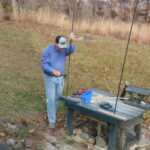
-
A few tools around the home help construct Fourth Floor Feeders
-
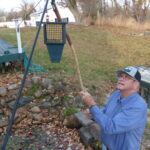
-
A pole with a hook makes lifting feeder high easy.
The birds love eating from the fourth story but there’s a problem. How to fill feeders so high up? Well, again, here’s how we solved the problem:
We scrounged a four-foot-long stick from a nearby lake that a beaver had cut and chewed off the bark. We bought an “S” hook from a hardware store and drilled a hole in the end of the stick. We pressed one side of the “S” hook into the wooden stick and had a handy tool.
With the hook on the stick, we can easily lift a feeder and hang it on the fourth story. A broomstick works as well as a beaver stick and the telescoping metal poles used to attach to paint rollers also can work. Most already have a hook built into the pole.
Squirrels can climb the steel shaft of the shepherd’s hook, but we foil them by coating its surface with a light spray of grease. Baffles are better at keeping these smart, pesky mammals at bay.
Materials Needed
Bird feeders
Picnic table
Shepherd’s Hook feeder holder
Pole for lifting feeder
“S” hookTube of spray grease
Helpful Tools
Drill and bit the same size as the shepherd’s hook’s diameter
Hammer
Although we still offer birdseed on the first, second, and third floors, now we present most of the seeds on the fourth floor. Saves seeds. Saves money. Frustrates deer, raccoons, turkeys, opossums, and squirrels.
-
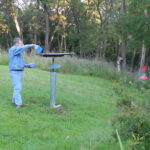
-
Hummingbird and platform feeders with baffle.
-
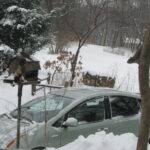
-
Squirrels quickly figure out how to access feeders
by Winding Pathways | Oct 27, 2022 | Birds, Nature
Hi all: Many people either don’t have feeders for birds or have reduced their giving of seeds due to higher expenses. Yet, we still like to note birds around. We encourage you to join Cornell University’s Project FeederWatch. From the website click on “About” on the tab and read more details of how you can enjoy watching and documenting birds starting November 1st.
-
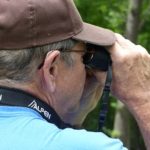
-
Bird watching is again a joy with hearing aids.
-
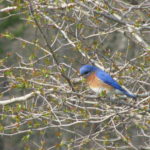
-
Bluebirds hang out on branches.
-
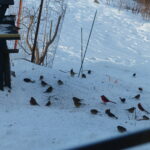
-
Birds flock to the seeds.
-
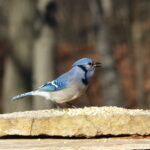
-
Usually jays come around only in winter.
-
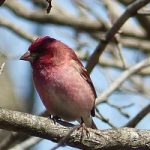
-
Some birds homestead at Winding Pathways.
-
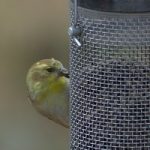
-
Songbirds appreciate high quality seed to sustain them in winter.
-
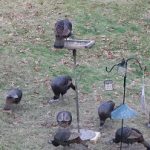
-
Turkeys and squirrels would make short work of seed, leaving none for the small birds.
-
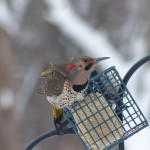
-
Winter is tough on birds so keep your feeders full.
-
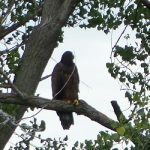
-
Fledgling eagle resting in the back yard.
by Winding Pathways | Sep 22, 2022 | (Sub)Urban Homesteading, Amphibians/Reptiles, Birds, Garden/Yard, Nature
We hadn’t seen either for a while but one September morning there they were. Mr. Toad and Ms. Wren.
Mr. Toad
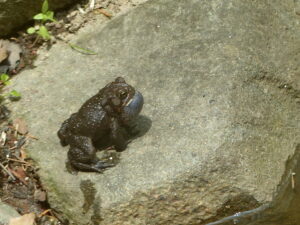
Toads sing loudly day and night.
All summer Mr. Toad contentedly lived beneath a tomato plant snacking on an occasional juicy bug. Ms. Wren meanwhile forayed about the yard snatching bugs and feeding her brood. In September Mr. Toad’s favorite tomato plant died back, probably tired after producing plenty of tasty fruits and no longer able to give Mr. Toad a worthy hiding place. And, after the babies fledged, Ms. Wren worked the prairie grasses and woods.
On that September morning, Rich noticed sweet potato leaves trembling a bit. He brushed aside the foliage and there was Mr. Toad out seeking breakfast.
The fall equinox is almost here. With it comes the short days and cool temperatures that make garden plants shrink. Mr. Toad is cold-blooded. Summer’s moist heat is to his liking, but before the cold comes, he must retire for the winter. So, down he goes, digging into the soil to find a place to snooze through the winter, no doubt dreaming about next summer’s juicy bugs under a new tomato plant.
We bid Mr. Toad adieu for the winter and said, “Thanks for helping with our gardening. See you next spring.”
Ms. Wren
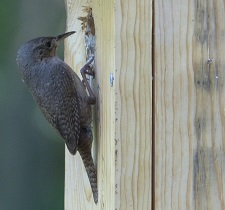
Checking the nest box.
Mr. Toad isn’t our only garden worker. Last winter we set up a wren house and by May Ms. Wren and her partner moved in. The couple raised two broods of ravenous babies in our garden. They enjoy the same fare as Mr. Toad but hunt more in our crop’s leaves instead of under them. The industrious parents spend nearly every daylight hour combing the garden and beyond for insects to feed their chicks.
Our last brood of garden wrens fledged in mid-August but stuck around a while. The family hunts insects in the woods behind the house but by the fall equinox they’ll get the urge to hop on a north wind some night and head south. When we’re shoveling snow, they’ll be snacking on bugs in a warm place.
Parting is Sweet Sorrow When Mr. Toad and Ms. Wren Bid Us Adieu
It’s hard to tell exactly when our wrens leave. Sometimes they linger into October but eventually one of us will say, “I haven’t seen or heard a wren for a while.” Yup, they’ve left for the season. We also bid them adieu and say, “Come back. See you next spring.” We miss Mr. Toad and Ms. Wren for the good work they do and for knowing we provide safe homes for them. We will put up wren boxes come March of next year and search for Mr. Toad sometime when the ground thaws.
About the Equinox
The Fall (autumnal) equinox is on or near September 21st. It’s one of two days when the sun crosses the celestial equator and every place on earth receives approximately 12 hours of daylight and 12 hours of darkness. The other is around March 21, the Vernal equinox. After the fall equinox the dark hours push daylight away until December 21 when days again begin to lengthen in the Northern Hemisphere. Plants and animals are super sensitive to day length and more aware of slight changes than most people.
by Winding Pathways | Sep 15, 2022 | (Sub)Urban Homesteading, Birds, Garden/Yard, Mammals, Nature, Pests
Guest Blog by Jackie Hull,
in the foothills of Virginia
Bears Barely Tolerable Behavior
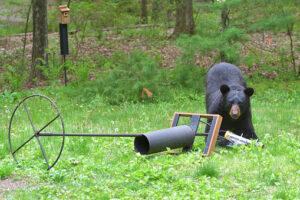
Bear Raiding Feeders
Well, the bear did it again. It tore up some of the spindles on the porch railing, tipped over a couple of the vegetable pots, and yanked a six-foot portion of our picket fence off the posts. All this to remind me that I should not feed the birds this time of year. It’s May.
So what to do but put away all the feeders? Maybe I can try again in the fall when bears retreat to the dens for their winter snooze.
This pretty much gave me great moments of sadness especially since I’ve had to shed other favorite activities.
Bird Antics Bring Joy
But today was a day of great surprises. My beautiful main stays, the birds, were everywhere. As I sat in the kitchen peering out the window, I spotted the adult turkeys poking their heads above the uncut hay. I could feel their parental thoughts “The coast is clear so keep scrambling forward.” The chicks were not seen but definitely there. A goldfinch zipped over them. Then I saw two wood thrashers near the holly tree scavenging for insects. Oh, my look how that crow struts!
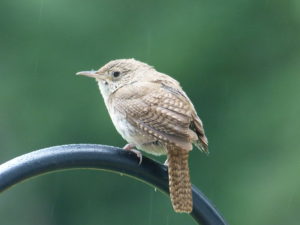
Wrens are Chatterers
Listen, that’s the wren by the back door. She keeps chattering to remind me she built her condo in the hanging planter. Then a flash of bright red caught my eye as I walked onto the porch. It’s a cardinal. Then the female house finch flicked from her nest over the front door light. She doesn’t like me stepping onto the porch. She is quite timid.
Even though the feeders have been down for nearly two months, the birds have kept their vigil at my country home much to my delight. They are in the trees, along the lane, and in the hayfield. What a great day!
by Winding Pathways | Sep 8, 2022 | (Sub)Urban Homesteading, Birds, Nature
Sometimes an animal’s name is misleading. Take the common nighthawks. It’s not a hawk and it doesn’t only fly at night. We often sit evenings on our back deck at Winding Pathways. In late summer 2022, we have been treated as dozens of aerial dancers – nighthawks – wheel overhead stalking mosquitoes and other insects. They can have all they can catch!
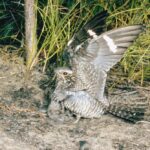
Common Nighthawks blend in with the ground. courtesy Free Photos
These birds are wonders. Closely related to whip-poor-wills, the brown feathers of the common nighthawk render them nearly invisible when resting in dry leaves or gravel during the day. They love evenings and wing overhead with their massive mouths open to snare tasty insects from the air.
Sometimes they pass just a few feet overhead. Occasionally they’re so high up that they are just fast-moving-turning-on-a-dime specks. Always they show distinct white stripes on the underside of their pointed wings.
Habits of Nighthawks
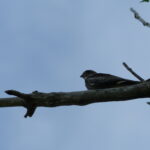
Resting nighthawk
We watched dozens of them in September 2022 and know that like many other migratory birds, they’ll join other birds for winter quarters in South America, so we enjoy them when we can. Daily we track bird migrations on the birdcast.info site. Nighthawks are one of the most widespread of North American birds, visible over farms, forests, and cities. Sometimes they even nest on gravel surfaced roofs of commercial buildings downtown and gravel areas of yards. We’ve caught glimpses of them resting on tree limbs. Watch the video to see many characteristics of nighthawks – their flight, sounds (listen for the “boom” of their wings), resting habits like sinking into the ground and yawning, and toward the end of this mini-documentary -the “waddle.” Fun!
Unfortunately, nighthawks have been declining about 1% a year since the 1960s. Why??? Pesticides, perhaps, reduce the insects that nighthawks feed on, and the loss of habitat. We don’t know for sure, but we enjoy watching their evening sky dance and hope people help them reverse their decline to continue their sky dance over much of the continent gobbling up insects.



























